Big Data Balamurugan Balusamy
Visit to download the full and correct content document: https://ebookmass.com/product/big-data-balamurugan-balusamy/

More products digital (pdf, epub, mobi) instant download maybe you interests ...
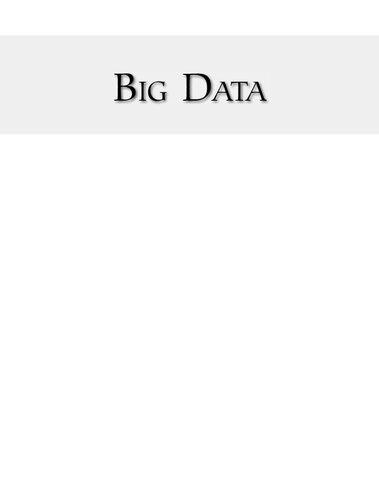
Big Data Anil Maheshwari
https://ebookmass.com/product/big-data-anil-maheshwari/

Process Safety and Big Data Sagit Valeev
https://ebookmass.com/product/process-safety-and-big-data-sagitvaleev/

The Big R-Book: From Data Science to Learning Machines and Big Data
Philippe J. S. De Brouwer
https://ebookmass.com/product/the-big-r-book-from-data-scienceto-learning-machines-and-big-data-philippe-j-s-de-brouwer/

Distrust: Big Data, Data-Torturing, and the Assault on Science Gary Smith
https://ebookmass.com/product/distrust-big-data-data-torturingand-the-assault-on-science-gary-smith/

Big Data Mining for Climate Change Zhihua Zhang
https://ebookmass.com/product/big-data-mining-for-climate-changezhihua-zhang/
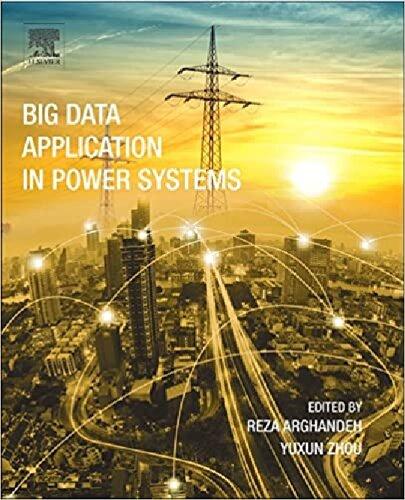
Big Data Application in Power Systems Reza Arghandeh
https://ebookmass.com/product/big-data-application-in-powersystems-reza-arghandeh/

Big Data in Astronomy: Scientific Data Processing for Advanced Radio Telescopes 1st Edition Linghe Kong (Editor)
https://ebookmass.com/product/big-data-in-astronomy-scientificdata-processing-for-advanced-radio-telescopes-1st-edition-linghekong-editor/

Big Data Management and Analytics Brij B Gupta & Mamta
https://ebookmass.com/product/big-data-management-and-analyticsbrij-b-gupta-mamta/

Big Data: An Art of Decision Making Eglantine Schmitt
https://ebookmass.com/product/big-data-an-art-of-decision-makingeglantine-schmitt/
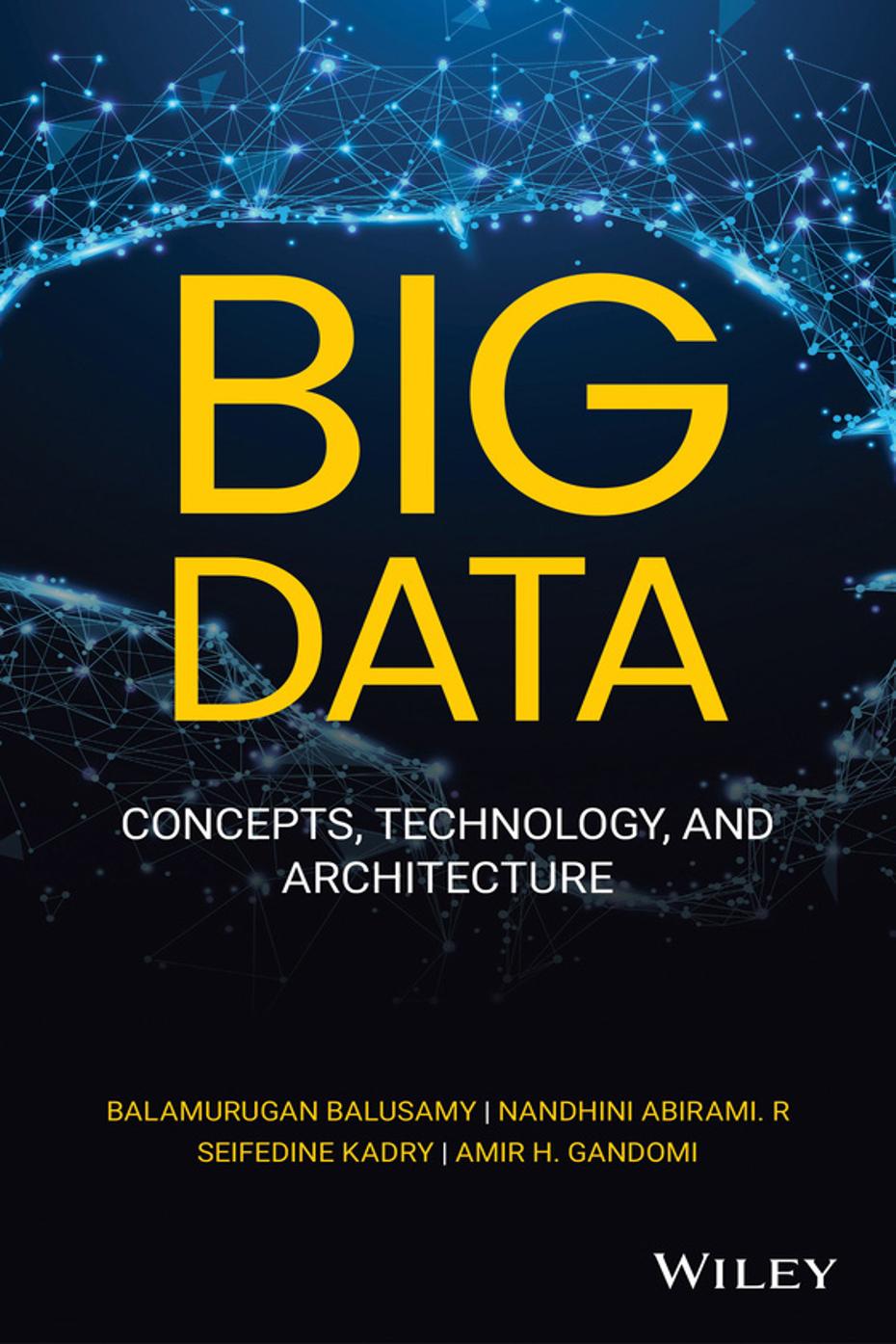
Big Data
Big Data
Concepts, Technology, and Architecture
Balamurugan Balusamy, Nandhini Abirami. R, Seifedine Kadry, and Amir H. Gandomi
This first edition first published 2021 © 2021 John Wiley & Sons, Inc.
All rights reserved. No part of this publication may be reproduced, stored in a retrieval system, or transmitted, in any form or by any means, electronic, mechanical, photocopying, recording or otherwise, except as permitted by law. Advice on how to obtain permission to reuse material from this title is available at http://www.wiley.com/go/permissions.
The right of Balamurugan Balusamy, Nandhini Abirami. R, Seifedine Kadry, and Amir H. Gandomi to be identified as the author(s) of this work has been asserted in accordance with law.
Registered Office
John Wiley & Sons, Inc., 111 River Street, Hoboken, NJ 07030, USA
Editorial Office
111 River Street, Hoboken, NJ 07030, USA
For details of our global editorial offices, customer services, and more information about Wiley products visit us at www.wiley.com.
Wiley also publishes its books in a variety of electronic formats and by print-on-demand. Some content that appears in standard print versions of this book may not be available in other formats.
Limit of Liability/Disclaimer of Warranty
While the publisher and authors have used their best efforts in preparing this work, they make no representations or warranties with respect to the accuracy or completeness of the contents of this work and specifically disclaim all warranties, including without limitation any implied warranties of merchantability or fitness for a particular purpose. No warranty may be created or extended by sales representatives, written sales materials or promotional statements for this work. The fact that an organization, website, or product is referred to in this work as a citation and/or potential source of further information does not mean that the publisher and authors endorse the information or services the organization, website, or product may provide or recommendations it may make. This work is sold with the understanding that the publisher is not engaged in rendering professional services. The advice and strategies contained herein may not be suitable for your situation. You should consult with a specialist where appropriate. Further, readers should be aware that websites listed in this work may have changed or disappeared between when this work was written and when it is read. Neither the publisher nor authors shall be liable for any loss of profit or any other commercial damages, including but not limited to special, incidental, consequential, or other damages.
Library of Congress Cataloging-in-Publication Data Applied for:
ISBN 978-1-119-70182-8
Cover Design: Wiley
Cover Image: © Illus_man /Shutterstock
Set in 9.5/12.5pt STIXTwoText by SPi Global, Pondicherry, India
10 9 8 7 6 5 4 3 2 1
To My Dear SAIBABA, IDKM KALIAMMA, My Beloved Wife Dr. Deepa Muthiah, Sweet Daughter Rhea, My dear Mother Mrs. Andal, Supporting father Mr. M. Balusamy, and ever-loving sister Dr. Bhuvaneshwari Suresh. Without all these people, I am no one.
To the people who mean a lot to me, my beloved daughter P. Rakshita, and my dear son P. Pranav Krishna.
-Nandhini Abirami. R
To My Family, and In Memory of My Grandparents Who Will Always Be In Our Hearts And Minds.
-Amir H. Gandomi
Contents
Acknowledgments xi
About the Author xii
1 Introduction to the World of Big Data 1
1.1 Understanding Big Data 1
1.2 Evolution of Big Data 2
1.3 Failure of Traditional Database in Handling Big Data 3
1.4 3 Vs of Big Data 4
1.5 Sources of Big Data 7
1.6 Different Types of Data 8
1.7 Big Data Infrastructure 11
1.8 Big Data Life Cycle 12
1.9 Big Data Technology 18
1.10 Big Data Applications 21
1.11 Big Data Use Cases 21
Chapter 1 Refresher 24
2 Big Data Storage Concepts 31
2.1 Cluster Computing 32
2.2 Distribution Models 37
2.3 Distributed File System 43
2.4 Relational and Non-Relational Databases 43
2.5 Scaling Up and Scaling Out Storage 47
Chapter 2 Refresher 48
3 NoSQL Database 53
3.1 Introduction to NoSQL 53
3.2 Why NoSQL 54
3.3 CAP Theorem 54
3.4 ACID 56
3.5 BASE 56
3.6 Schemaless Databases 57
3.7 NoSQL (Not Only SQL) 57
3.8 Migrating from RDBMS to NoSQL 76
Chapter 3 Refresher 77
4 Processing, Management Concepts, and Cloud Computing 83
Part I: Big Data Processing and Management Concepts 83
4.1 Data Processing 83
4.2 Shared Everything Architecture 85
4.3 Shared-Nothing Architecture 86
4.4 Batch Processing 88
4.5 Real-Time Data Processing 88
4.6 Parallel Computing 89
4.7 Distributed Computing 90
4.8 Big Data Virtualization 90
Part II: Managing and Processing Big Data in Cloud Computing 93
4.9 Introduction 93
4.10 Cloud Computing Types 94
4.11 Cloud Services 95
4.12 Cloud Storage 96
4.13 Cloud Architecture 101
Chapter 4 Refresher 103
5 Driving Big Data with Hadoop Tools and Technologies 111
5.1 Apache Hadoop 111
5.2 Hadoop Storage 114
5.3 Hadoop Computation 119
5.4 Hadoop 2.0 129
5.5 HBASE 138
5.6 Apache Cassandra 141
5.7 SQOOP 141
5.8 Flume 143
5.9 Apache Avro 144
5.10 Apache Pig 145
5.11 Apache Mahout 146
5.12 Apache Oozie 146
5.13 Apache Hive 149
5.14 Hive Architecture 151
5.15 Hadoop Distributions 152
Chapter 5 Refresher 153
6 Big Data Analytics 161
6.1 Terminology of Big Data Analytics 161
6.2 Big Data Analytics 162
6.3 Data Analytics Life Cycle 166
6.4 Big Data Analytics Techniques 170
6.5 Semantic Analysis 175
6.6 Visual analysis 178
6.7 Big Data Business Intelligence 178
6.8 Big Data Real-Time Analytics Processing 180
6.9 Enterprise Data Warehouse 181
Chapter 6 Refresher 182
7 Big Data Analytics with Machine Learning 187
7.1 Introduction to Machine Learning 187
7.2 Machine Learning Use Cases 188
7.3 Types of Machine Learning 189
Chapter 7 Refresher 196
8 Mining Data Streams and Frequent Itemset 201
8.1 Itemset Mining 201
8.2 Association Rules 206
8.3 Frequent Itemset Generation 210
8.4 Itemset Mining Algorithms 211
8.5 Maximal and Closed Frequent Itemset 229
8.6 Mining Maximal Frequent Itemsets: the GenMax Algorithm 233
8.7 Mining Closed Frequent Itemsets: the Charm Algorithm 236
8.8 CHARM Algorithm Implementation 236
8.9 Data Mining Methods 239
8.10 Prediction 240
8.11 Important Terms Used in Bayesian Network 241
8.12 Density Based Clustering Algorithm 249
8.13 DBSCAN 249
8.14 Kernel Density Estimation 250
8.15 Mining Data Streams 254
8.16 Time Series Forecasting 255
Contents x
9 Cluster Analysis 259
9.1 Clustering 259
9.2 Distance Measurement Techniques 261
9.3 Hierarchical Clustering 263
9.4 Analysis of Protein Patterns in the Human Cancer-Associated Liver 266
9.5 Recognition Using Biometrics of Hands 267
9.6 Expectation Maximization Clustering Algorithm 274
9.7 Representative-Based Clustering 277
9.8 Methods of Determining the Number of Clusters 277
9.9 Optimization Algorithm 284
9.10 Choosing the Number of Clusters 288
9.11 Bayesian Analysis of Mixtures 290
9.12 Fuzzy Clustering 290
9.13 Fuzzy C-Means Clustering 291
10 Big Data Visualization 293
10.1 Big Data Visualization 293
10.2 Conventional Data Visualization Techniques 294
10.3 Tableau 297
10.4 Bar Chart in Tableau 309
10.5 Line Chart 310
10.6 Pie Chart 311
10.7 Bubble Chart 312
10.8 Box Plot 313
10.9 Tableau Use Cases 313
10.10 Installing R and Getting Ready 318
10.11 Data Structures in R 321
10.12 Importing Data from a File 335
10.13 Importing Data from a Delimited Text File 336
10.14 Control Structures in R 337
10.15 Basic Graphs in R 341
Index 347
Acknowledgments
Writing a book is harder than I thought and more rewarding than I could have ever imagined. None of this would have been possible without my family. I wish to extend my profound gratitude to my father, Mr. N. J. Rajendran and my mother, Mrs. Mallika Rajendran, for their moral support. I salute you for the selfless love, care, pain, and sacrifice you did to shape my life. Special mention goes to my father, who supported throughout my education, career, and encouraged me to pursue my higher studies. It is my fortune to gratefully acknowledge my sisters, DR. R. Vidhya Lakshmi and Mrs. R. Rajalakshmi Priyanka, for their support and generous care throughout my education and career. They were always beside me during the happy and hard moments to push me and motivate me. With great pleasure, I acknowledge the people who mean a lot to me, my beloved daughter P. Rakshita, and my dear son P. Pranav Krishna without whose cooperation, writing this book would not be possible. I owe thanks to a very special person, my husband, Mr. N. Pradeep, for his continued and unfailing support and understanding. I would like to extend my love and thanks to my dears, Nila Nagarajan, Akshara Nagarajan, Vaibhav Surendran, and Nivin Surendran. I would also like to thank my mother‐in‐law Mrs. Thenmozhi Nagarajan who supported me in all possible means to pursue my career.
About the Author
Balamurugan Balusamy is the professor of Data Sciences and Chief Research Coordinator at Galgotias University, NCR, India. His research focuses on the role of Data Sciences in various domains. He is the author of over a hundred Journal papers and book chapters on Data Sciences, IoT, and Blockchain. He has chaired many International Conferences and had given multiple Keynote addresses in Top Notch conferences across the Globe. He holds a Doctorate degree, masters, and Bachelors degree in Computer Science and Engineering from Premier Institutions. In his spare time, he likes to do Yoga and Meditation.
Nandhini Abirami R is a first year PhD student and a Research Associate in the School of Information Technology at Vellore Institute of Technology. Her doctoral research investigates the advancement and effectiveness of Generative Adversarial Network in computer vision. She takes a multidisciplinary approach that encompasses the fields of healthcare and human computer interaction. She holds a master’s degree in Information Technology from Vellore Institute of Technology, which investigated the effectiveness of machine learning algorithms in predicting heart disease. She worked as Assistant Systems Engineer at Tata Consultancy Services.
Amir H. Gandomi is a Professor of Data Science and an ARC DECRA Fellow at the Faculty of Engineering & Information Technology, University of Technology Sydney. Prior to joining UTS, Prof. Gandomi was an Assistant Professor at Stevens Institute of Technology, USA and a distinguished research fellow in BEACON center, Michigan State University, USA. Prof. Gandomi has published over two hundred journal papers and seven books which collectively have been cited 19,000+ times (H-index = 64). He has been named as one of the most influential scientific mind and Highly Cited Researcher (top 1% publications and 0.1% researchers) for four consecutive years, 2017 to 2020. He also ranked 18th in GP bibliography among more than 12,000 researchers. He has served as associate editor, editor and guest editor in several prestigious journals such as AE of SWEVO, IEEE TBD, and IEEE IoTJ. Prof Gandomi is active in delivering keynotes and invited talks. His research interests are global optimisation and (big) data analytics using machine learning and evolutionary computations in particular.
Introduction to the World of Big Data
CHAPTER OBJECTIVE
This chapter deals with the introduction to big data, defining what actually big data means. The limitations of the traditional database, which led to the evolution of Big Data, are explained, and insight into big data key concepts is delivered. A comparative study is made between big data and traditional database giving a clear picture of the drawbacks of the traditional database and advantages of big data. The three Vs of big data (volume, velocity, and variety) that distinguish it from the traditional database are explained. With the evolution of big data, we are no longer limited to the structured data. The different types of human- and machine-generated data—that is, structured, semi-structured, and unstructured—that can be handled by big data are explained. The various sources contributing to this massive volume of data are given a clear picture. The chapter expands to show the various stages of big data life cycle starting from data generation, acquisition, preprocessing, integration, cleaning, transformation, analysis, and visualization to make business decisions. This chapter sheds light on various challenges of big data due to its heterogeneity, volume, velocity, and more.
1.1 Understanding Big Data
With the rapid growth of Internet users, there is an exponential growth in the data being generated. The data is generated from millions of messages we send and communicate via WhatsApp, Facebook, or Twitter, from the trillions of photos taken, and hours and hours of videos getting uploaded in YouTube every single minute. According to a recent survey 2.5 quintillion (2 500 000 000 000 000 000, or 2.5 × 1018) bytes of data are generated every day. This enormous amount of data generated is referred to as “big data.” Big data does not only mean that the data sets are too large, it is a blanket term for the data that are too large in size, complex in nature, which may be structured or
Big Data: Concepts, Technology, and Architecture, First Edition. Balamurugan Balusamy, Nandhini Abirami. R, Seifedine Kadry, and Amir H. Gandomi.
© 2021 John Wiley & Sons, Inc. Published 2021 by John Wiley & Sons, Inc.
unstructured, and arriving at high velocity as well. Of the data available today, 80 percent has been generated in the last few years. The growth of big data is fueled by the fact that more data are generated on every corner of the world that needs to be captured.
Capturing this massive data gives only meager value unless this IT value is transformed into business value. Managing the data and analyzing them have always been beneficial to the organizations; on the other hand, converting these data into valuable business insights has always been the greatest challenge. Data scientists were struggling to find pragmatic techniques to analyze the captured data. The data has to be managed at appropriate speed and time to derive valuable insight from it. These data are so complex that it became difficult to process it using traditional database management systems, which triggered the evolution of the big data era. Additionally, there were constraints on the amount of data that traditional databases could handle. With the increase in the size of data either there was a decrease in performance and increase in latency or it was expensive to add additional memory units. All these limitations have been overcome with the evolution of big data technologies that lets us capture, store, process, and analyze the data in a distributed environment. Examples of Big data technologies are Hadoop, a framework for all big data process, Hadoop Distributed File System (HDFS) for distributed cluster storage, and MapReduce for processing.
1.2 Evolution of Big Data
The first documentary appearance of big data was in a paper in 1997 by NASA scientists narrating the problems faced in visualizing large data sets, which were a captivating challenge for the data scientists. The data sets were large enough, taxing more memory resources. This problem is termed big data. Big data, the broader concept, was first put forward by a noted consultancy: McKinsey. The three dimensions of big data, namely, volume, velocity, and variety, were defined by analyst Doug Laney. The processing life cycle of big data can be categorized into acquisition, preprocessing, storage and management, privacy and security, analyzing, and visualization.
The broader term big data encompasses everything that includes web data, such as click stream data, health data of patients, genomic data from biologic research, and so forth.
Figure 1.1 shows the evolution of big data. The growth of the data over the years is massive. It was just 600 MB in the 1950s but has grown by 2010 up to 100 petabytes, which is equal to 100 000 000 000 MB.
Evolution of Big Data
Data growth over the years
Data In Megabytes
1.3 Failure of Traditional Database in Handling Big Data
The Relational Database Management Systems (RDBMS) was the most prevalent data storage medium until recently to store the data generated by the organizations. A large number of vendors provide database systems. These RDBMS were devised to store the data that were beyond the storage capacity of a single computer. The inception of a new technology is always due to limitations in the older technologies and the necessity to overcome them. Below are the limitations of traditional database in handling big data.
● Exponential increase in data volume, which scales in terabytes and petabytes, has turned out to become a challenge to the RDBMS in handling such a massive volume of data.
● To address this issue, the RDBMS increased the number of processors and added more memory units, which in turn increased the cost.
● Almost 80% of the data fetched were of semi-structured and unstructured format, which RDBMS could not deal with.
● RDBMS could not capture the data coming in at high velocity.
Table 1.1 shows the differences in the attributes of RDBMS and big data.
1.3.1 Data Mining vs. Big Data
Table 1.2 shows a comparison between data mining and big data.
1 Introduction to the World of Big Data
Table 1.1 Differences in the attributes of big data and RDBMS.
ATTRIBUTES RDBMS BIG
DATA
Data volume gigabytes to terabytes petabytes to zettabytes
Organization centralized distributed
Data type structured unstructured and semi-structured
Hardware type high-end model commodity hardware
Updates read/write many times write once, read many times
Schema static dynamic
Table 1.2 Data Mining vs. Big Data.
S. No. Data mining Big data
1) Data mining is the process of discovering the underlying knowledge from the data sets.
2) Structured data retrieved from spread sheets, relational databases, etc.
3) Data mining is capable of processing large data sets, but the data processing costs are high.
4) Data mining can process only data sets that range from gigabytes to terabytes.
1.4 3 Vs of Big Data
Big data refers to massive volume of data characterized by volume, velocity, and variety.
Structured, unstructured, or semi-structured data retrieved from non-relational databases, such as NoSQl.
Big data tools and technologies are capable of storing and processing large volumes of data at a comparatively lower cost.
Big data technology is capable of storing and processing data that range from petabytes to zettabytes.
Big data is distinguished by its exceptional characteristics with various dimensions. Figure 1.2 illustrates various dimensions of big data. The first of its dimensions is the size of the data. Data size grows partially because the cluster storage with commodity hardware has made it cost effective. Commodity hardware is a low cost, low performance, and low specification functional hardware with no distinctive features. This is referred by the term “volume” in big data technology. The second dimension is the variety, which describes its heterogeneity to accept all the data types, be it structured, unstructured, or a mix of both. The third dimension is velocity, which relates to the rate at which the data is generated and being processed to derive the desired value out of the raw unprocessed data.
Structured Unstructured
Semi-Structured
Terabyte
Petabyte
Zetabyte
Speed Of generation
Rate of analysis
Figure 1.2 3 Vs of big data.
The complexities of the data captured pose a new opportunity as well as a challenge for today’s information technology era.
1.4.1 Volume
Data generated and processed by big data are continuously growing at an ever increasing pace. Volume grows exponentially owing to the fact that business enterprises are continuously capturing the data to make better and bigger business solutions. Big data volume measures from terabytes to zettabytes (1024 GB = 1 terabyte; 1024 TB = 1 petabyte; 1024 PB = 1 exabyte; 1024 EB = 1 zettabyte; 1024 ZB = 1 yottabyte). Capturing this massive data is cited as an extraordinary opportunity to achieve finer customer service and better business advantage. This ever increasing data volume demands highly scalable and reliable storage. The major sources contributing to this tremendous growth in the volume are social media, point of sale (POS) transactions, online banking, GPS sensors, and sensors in vehicles. Facebook generates approximately 500 terabytes of data per day. Every time a link on a website is clicked, an item is purchased online, a video is uploaded in YouTube, data are generated.
1.4.2 Velocity
With the dramatic increase in the volume of data, the speed at which the data is generated also surged up. The term “velocity” not only refers to the speed at which data are generated, it also refers to the rate at which data is processed and
Data generated in 60 seconds
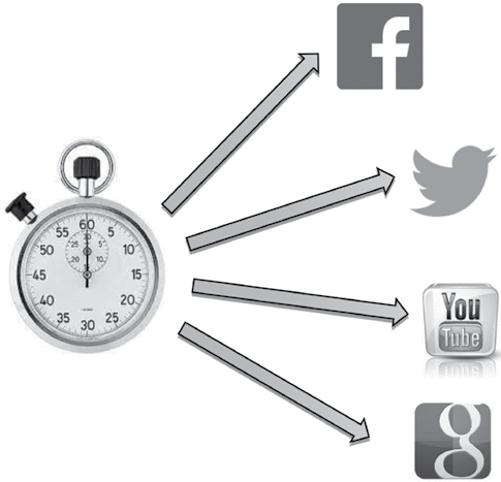
1.3
3.3 million Posts 4.5 lakh tweets
400 hours of video upload
3.1 million Google searches
analyzed. In the big data era, a massive amount of data is generated at high velocity, and sometimes these data arrive so fast that it becomes difficult to capture them, and yet the data needs to be analyzed. Figure 1.3 illustrates the data generated with high velocity in 60 seconds: 3.3 million Facebook posts, 450 thousand tweets, 400 hours of video upload, and 3.1 million Google searches.
1.4.3 Variety
Variety refers to the format of data supported by big data. Data arrives in structured, semi-structured, and unstructured format. Structured data refers to the data processed by traditional database management systems where the data are organized in tables, such as employee details, bank customer details. Semistructured data is a combination of structured and unstructured data, such as XML. XML data is semi-structured since it does not fit the formal data model (table) associated with traditional database; rather, it contains tags to organize fields within the data. Unstructured data refers to data with no definite structure, such as e-mail messages, photos, and web pages. The data that arrive from Facebook, Twitter feeds, sensors of vehicles, and black boxes of airplanes are all

1.4 Big data—data variety.
unstructured, which the traditional database cannot process, and here is when big data comes into the picture. Figure 1.4 represents the different data types.
1.5 Sources of Big Data
Multiple disparate data sources are responsible for the tremendous increase in the volume of big data. Much of the growth in data can be attributed to the digitization of almost anything and everything in the globe. Paying E-bills, online shopping, communication through social media, e-mail transactions in various organizations, a digital representation of the organizational data, and so forth, are some of the examples of this digitization around the globe.
● Sensors: Sensors that contribute to the large volume of big data are listed below.
– Accelerometer sensors installed in mobile devices to sense the vibrations and other movements.
– Proximity Sensors used in public places to detect the presence of objects without physical contact with the objects.
– Sensors in vehicles and medical devices.
● Health care: The major sources of big data in health care are:
– Electronic Health Records (EHRs) collect and display patient information such as past medical history, prescriptions by the medical practitioners, and laboratory test results.
– Patient portals permit patients to access their personal medical records saved in EHRs.
– Clinical data repository aggregates individual patient records from various clinical sources and consolidates them to give a unified view of patient history.
● Black box: Data are generated by the black box in airplanes, helicopters, and jets. The black box captures the activities of flight, flight crew announcements, and aircraft performance information.

Figure 1.5 Sources of big data.
● Web data: Data generated on clicking a link on a website is captured by the online retailers. This is perform click stream analysis to analyze customer interest and buying patterns to generate recommendations based on the customer interests and to post relevant advertisements to the consumers.
● Organizational data: E-mail transactions and documents that are generated within the organizations together contribute to the organizational data.
Figure 1.5 illustrates the data generated by various sources that were discussed above.
1.6 Different Types of Data
Data may be machine generated or human generated. Human-generated data refers to the data generated as an outcome of interactions of humans with the machines. E-mails, documents, Facebook posts are some of the human-generated data. Machine-generated data refers to the data generated by computer applications or hardware devices without active human intervention. Data from sensors, disaster warning systems, weather forecasting systems, and satellite data are some of the machine-generated data. Figure 1.6 represents the data generated by a
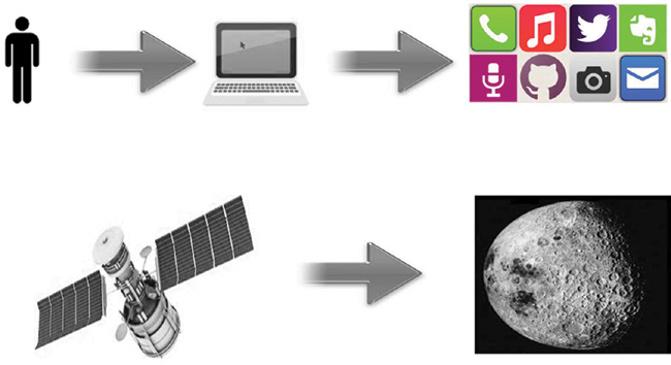
human in various social media, e-mails sent, and pictures that were taken by them and machine data generated by the satellite.
The machine-generated and human-generated data can be represented by the following primitive types of big data:
● Structured data
● Unstructured data
● Semi-structured data
1.6.1 Structured Data
Data that can be stored in a relational database in table format with rows and columns is called structured data. Structured data often generated by business enterprises exhibits a high degree of organization and can easily be processed using data mining tools and can be queried and retrieved using the primary key field. Examples of structured data include employee details and financial transactions. Figure 1.7 shows an example of structured data, employee details table with EmployeeID as the key.
1.6.2 Unstructured Data
Data that are raw, unorganized, and do not fit into the relational database systems are called unstructured data. Nearly 80% of the data generated are unstructured. Examples of unstructured data include video, audio, images, e-mails, text files,
Employee
334332
334333
338332
339232
337891
339876
Daniel Male $2300
MichaelMale$2800
AgnesFemale$4000
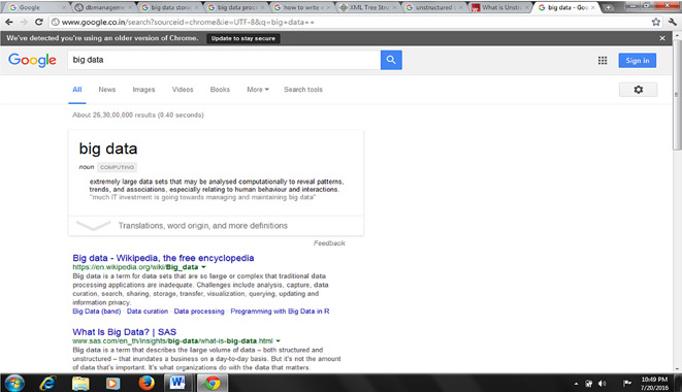
and social media posts. Unstructured data usually reside on either text files or binary files. Data that reside in binary files do not have any identifiable internal structure, for example, audio, video, and images. Data that reside in text files are e-mails, social media posts, pdf files, and word processing documents. Figure 1.8 shows unstructured data, the result of a Google search.
1.6.3 Semi-Structured Data
Semi-structured data are those that have a structure but do not fit into the relational database. Semi-structured data are organized, which makes it easier to analyze when compared to unstructured data. JSON and XML are examples of semi-structured data. Figure 1.9 is an XML file that represents the details of an employee in an organization.
<?xml version = “1.0”?>
<Company> <Employee>
<EmployeeId>339876</EmployeeId> <FirstName>Joseph</FirstName> <LastName>Agnes</LastName> <Sex>Female</Sex> <Salary>$4000<Salary> </Employee> </Company>
Figure 1.9 XML file with employee details.
1.7 Big Data Infrastructure
The core components of big data technologies are the tools and technologies that provide the capacity to store, process, and analyze the data. The method of storing the data in tables was no longer supportive with the evolution of data with 3 Vs, namely volume, velocity, and variety. The robust RBDMS was no longer cost effective. The scaling of RDBMS to store and process huge amount of data became expensive. This led to the emergence of new technology, which was highly scalable at very low cost.
The key technologies include
● Hadoop
● HDFS
● MapReduce
Hadoop – Apache Hadoop, written in Java, is open-source framework that supports processing of large data sets. It can store a large volume of structured, semi-structured, and unstructured data in a distributed file system and process them in parallel. It is a highly scalable and cost-effective storage platform. Scalability of Hadoop refers to its capability to sustain its performance even under highly increasing loads by adding more nodes. Hadoop files are written once and read many times. The contents of the files cannot be changed. A large number of computers interconnected working together as a single system is called a cluster. Hadoop clusters are designed to store and analyze the massive amount of disparate data in distributed computing environments in a cost effective manner.
Hadoop Distributed File system – HDFS is designed to store large data sets with streaming access pattern running on low-cost commodity hardware. It does not require highly reliable, expensive hardware. The data set is generated from multiple sources, stored in an HDFS file system in a write-once, read-many-times pattern, and analyses are performed on the data set to extract knowledge from it.
MapReduce – MapReduce is the batch-processing programming model for the Hadoop framework, which adopts a divide-and-conquer principle. It is highly scalable, reliable, and fault tolerant, capable of processing input data with any format in parallel and distributed computing environments supporting only batch workloads. Its performance reduces the processing time significantly compared to the traditional batch-processing paradigm, as the traditional approach was to move the data from the storage platform to the processing platform, whereas the MapReduce processing paradigm resides in the framework where the data actually resides.
1.8 Big Data Life Cycle
Big data yields big benefits, starting from innovative business ideas to unconventional ways to treat diseases, overcoming the challenges. The challenges arise because so much of the data is collected by the technology today. Big data technologies are capable of capturing and analyzing them effectively. Big data infrastructure involves new computing models with the capability to process both distributed and parallel computations with highly scalable storage and performance. Some of the big data components include Hadoop (framework), HDFS (storage), and MapReduce (processing).
Figure 1.10 illustrates the big data life cycle. Data arriving at high velocity from multiple sources with different data formats are captured. The captured data is stored in a storage platform such as HDFS and NoSQL and then preprocessed to make the data suitable for analysis. The preprocessed data stored in the storage platform is then passed to the analytics layer, where the data is processed using big data tools such as MapReduce and YARN and analysis is performed on the processed data to uncover hidden knowledge from it. Analytics and machine learning are important concepts in the life cycle of big data. Text analytics is a type of analysis performed on unstructured textual data. With the growth of social media and e-mail transactions, the importance of text analytics has surged up. Predictive analysis on consumer behavior and consumer interest analysis are all performed on the text data extracted from various online sources such as social media, online retailing websites, and much more. Machine learning has made text analytics possible. The analyzed data is visually represented by visualization tools such as Tableau to make it easily understandable by the end user to make decisions.
1.8.1 Big Data Generation
The first phase of the life cycle of big data is the data generation. The scale of data generated from diversified sources is gradually expanding. Sources of this large volume of data were discussed under the Section 1.5, “Sources of Big Data.”

1.8.2 Data Aggregation
The data aggregation phase of the big data life cycle involves collecting the raw data, transmitting the data to the storage platform, and preprocessing them. Data acquisition in the big data world means acquiring the high-volume data arriving at an ever-increasing pace. The raw data thus collected is transmitted to a proper storage infrastructure to support processing and various analytical applications. Preprocessing involves data cleansing, data integration, data transformation, and data reduction to make the data reliable, error free, consistent, and accurate. The data gathered may have redundancies, which occupy the storage space and increase the storage cost and can be handled by data preprocessing. Also, much of the data gathered may not be related to the analysis objective, and hence it needs to be compressed while being preprocessed. Hence, efficient data preprocessing is indispensable for cost-effective and efficient data storage. The preprocessed data are then transmitted for various purposes such as data modeling and data analytics.
1.8.3 Data Preprocessing
Data preprocessing is an important process performed on raw data to transform it into an understandable format and provide access to consistent and accurate data. The data generated from multiple sources are erroneous, incomplete, and inconsistent because of their massive volume and heterogeneous sources, and it is meaningless to store useless and dirty data. Additionally, some analytical applications have a crucial requirement for quality data. Hence, for effective, efficient, and accurate data analysis, systematic data preprocessing is essential. The quality of the source data is affected by various factors. For instance, the data may have errors such as a salary field having a negative value (e.g., salary = −2000), which arises because of transmission errors or typos or intentional wrong data entry by users who do not wish to disclose their personal information. Incompleteness implies that the field lacks the attributes of interest (e.g., Education = “”), which may come from a not applicable field or software errors. Inconsistency in the data refers to the discrepancies in the data, say date of birth and age may be inconsistent. Inconsistencies in data arise when the data collected are from different sources, because of inconsistencies in naming conventions between different countries and inconsistencies in the input format (e.g., date field DD/MM when interpreted as MM/DD). Data sources often have redundant data in different forms, and hence duplicates in the data also have to be removed in data preprocessing to make the data meaningful and error free. There are several steps involved in data preprocessing:
1) Data integration
2) Data cleaning
3) Data reduction
4) Data transformation
1.8.3.1
Data Integration
Data integration involves combining data from different sources to give the end users a unified data view. Several challenges are faced while integrating data; as an example, while extracting data from the profile of a person, the first name and family name may be interchanged in a certain culture, so in such cases integration may happen incorrectly. Data redundancies often occur while integrating data from multiple sources. Figure 1.11 illustrates that diversified sources such as organizations, smartphones, personal computers, satellites, and sensors generate disparate data such as e-mails, employee details, WhatsApp chat messages, social media posts, online transactions, satellite images, and sensory data. These different types of structured, unstructured, and semistructured data have to be integrated and presented as unified data for data cleansing, data modeling, data warehousing, and to extract, transform, and load (ETL) the data.
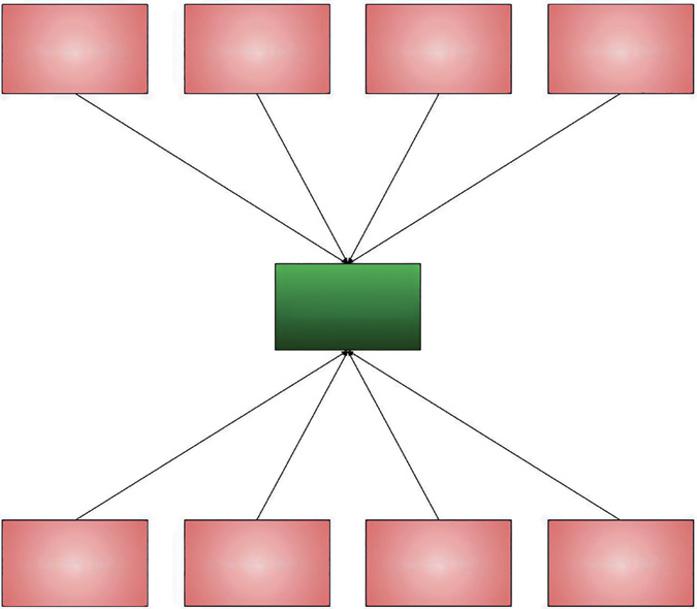
1.8.3.2
Data Cleaning
The data-cleaning process fills in the missing values, corrects the errors and inconsistencies, and removes redundancy in the data to improve the data quality. The larger the heterogeneity of the data sources, the higher the degree of dirtiness. Consequently, more cleaning steps may be involved. Data cleaning involves several steps such as spotting or identifying the error, correcting the error or deleting the erroneous data, and documenting the error type. To detect the type of error and inconsistency present in the data, a detailed analysis of the data is required. Data redundancy is the data repetition, which increases storage cost and transmission expenses and decreases data accuracy and reliability. The various techniques involved in handling data redundancy are redundancy detection and data compression. Missing values can be filled in manually, but it is tedious, time-consuming, and not appropriate for the massive volume of data. A global constant can be used to fill in all the missing values, but this method creates issues while integrating the data; hence, it is not a foolproof method. Noisy data can be handled by four methods, namely, regression, clustering, binning, and manual inspection.
1.8.3.3
Data Reduction
Data processing on massive data volume may take a long time, making data analysis either infeasible or impractical. Data reduction is the concept of reducing the volume of data or reducing the dimension of the data, that is, the number of attributes. Data reduction techniques are adopted to analyze the data in reduced format without losing the integrity of the actual data and yet yield quality outputs. Data reduction techniques include data compression, dimensionality reduction, and numerosity reduction. Data compression techniques are applied to obtain the compressed or reduced representation of the actual data. If the original data is retrieved back from the data that is being compressed without any loss of information, then it is called lossless data reduction. On the other hand, if the data retrieval is only partial, then it is called lossy data reduction. Dimensionality reduction is the reduction of a number of attributes, and the techniques include wavelet transforms where the original data is projected into a smaller space and attribute subset selection, a method which involves removal of irrelevant or redundant attributes. Numerosity reduction is a technique adopted to reduce the volume by choosing smaller alternative data. Numerosity reduction is implemented using parametric and nonparametric methods. In parametric methods instead of storing the actual data, only the parameters are stored. Nonparametric methods stores reduced representations of the original data.
1.8.3.4
Data Transformation
Data transformation refers to transforming or consolidating the data into an appropriate format and converting them into logical and meaningful information for data management and analysis. The real challenge in data transformation
